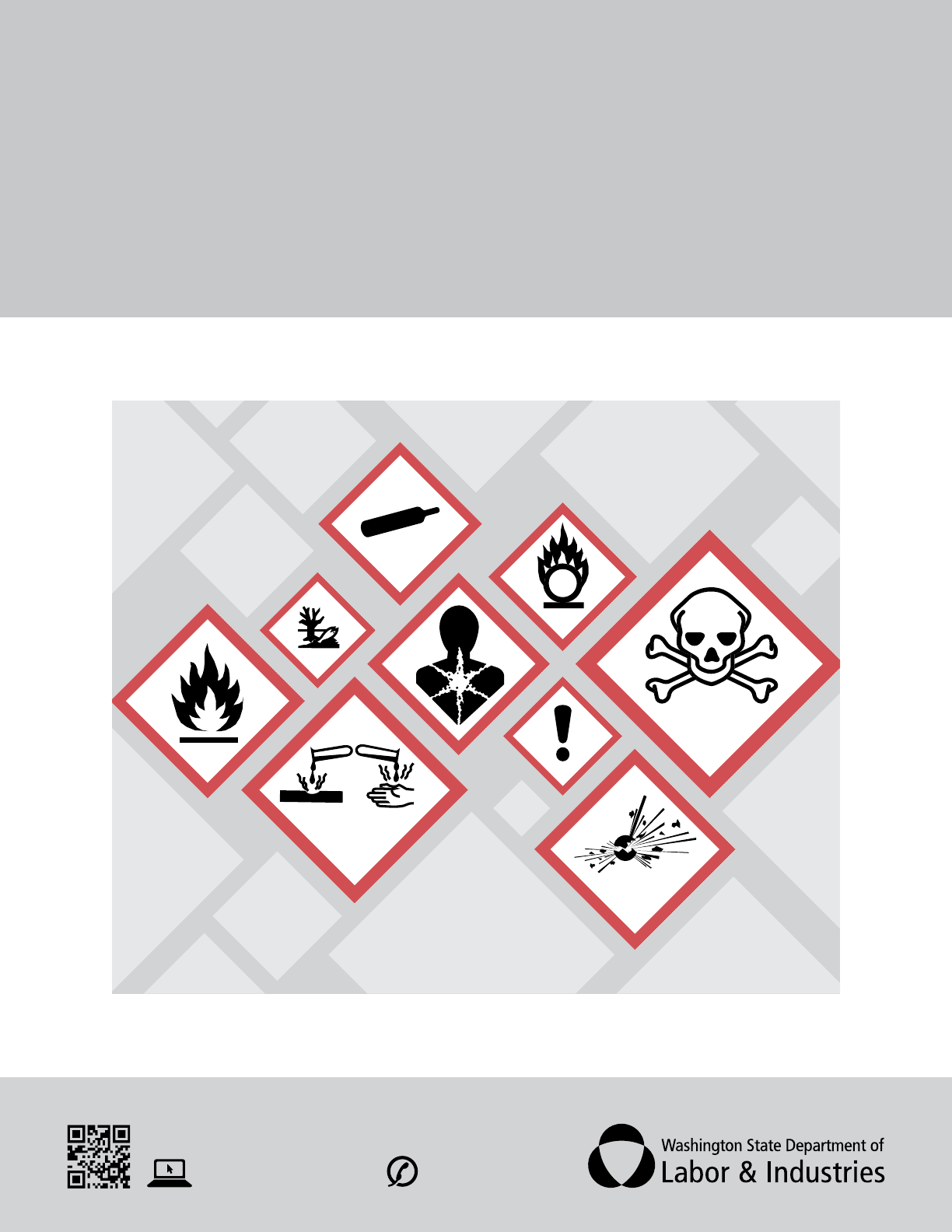
Employer’s Guide to the
Hazard Communication Rule
Division of Occupational Safety and Health
www.Lni.wa.gov/Safety 1-800-423-7233
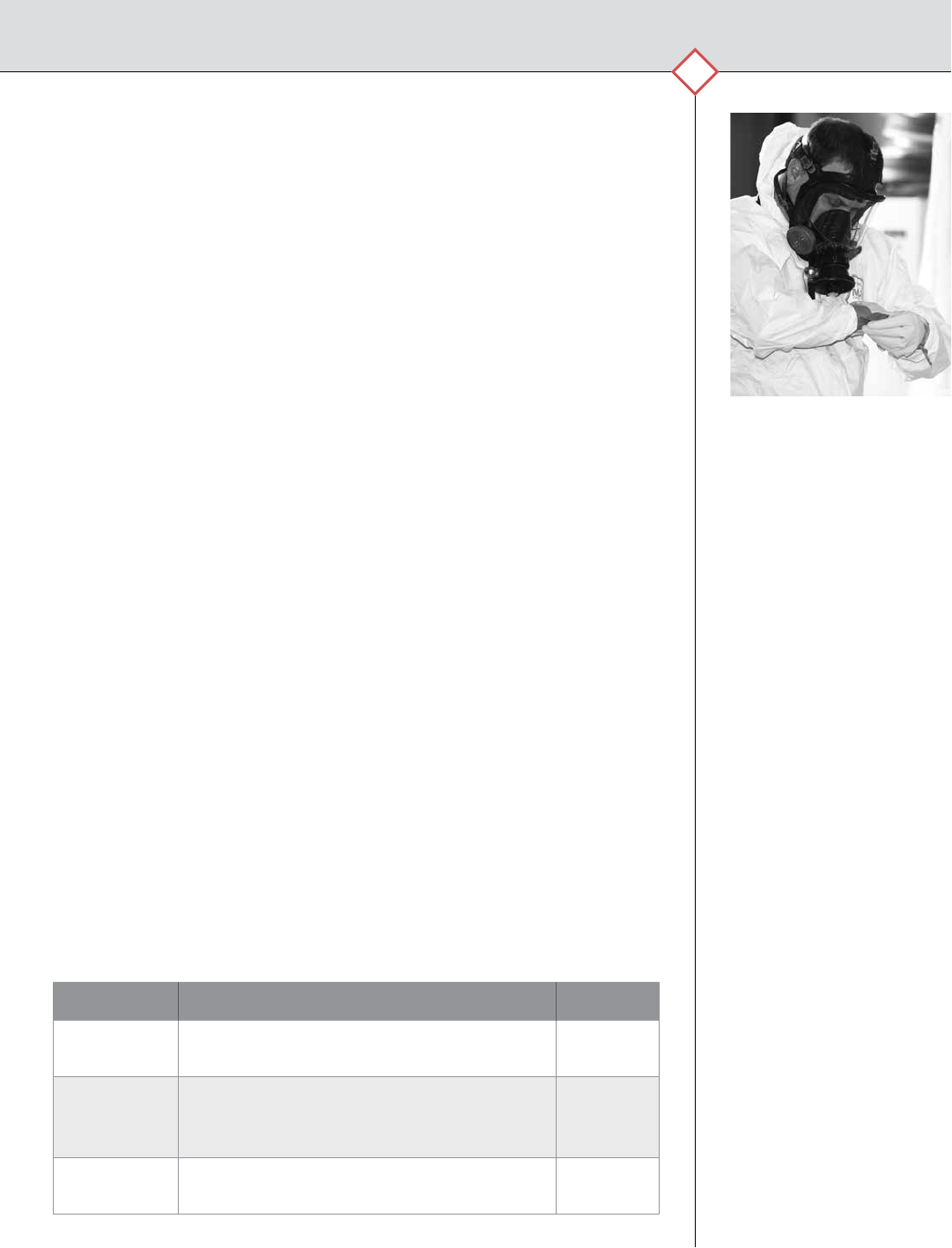
1
What is the Hazard Communication rule?
The Hazard Communication rule requires you
—
the employer
—
to inform and train your employees about hazardous chemicals in
your workplace.
Note: Washington State’s new Hazard Communication rule,
WAC 296-901-140, became effective April 15, 2013. It replaces the
Employer Hazard Communication rule, WAC 296-800-170.
The changes are based on the International Globally Harmonized
System of Classication and Labeling of Chemicals (GHS) and are
intended to improve comprehension of hazard information found
on product labels. For more information about GHS and Hazard
Communication, visit www.Lni.wa.gov/Safety/Topics/AtoZ/GHS .
The major changes include:
Hazard Classication providing specic criteria for classication of
health and physical hazards, as well as classication of mixtures.
More standardized labels that feature:
-
Hazard pictograms
-
A signal word, such as “Danger”
-
Hazard statement for each hazard class and category, including
precautionary statements
-
A product identier and a supplier identier
Safety Data Sheets (SDSs) that follow a standardized 16-section
format to replace Material Safety Data Sheets (MSDSs.)
Although content details on labels and SDSs are affected by the GHS,
many of the current requirements are not changing. For example,
requirements to distribute SDSs, label workplace containers and train
employees remain the same.
Employers must comply with changes to the rule according to the
following schedule:
Who What By Date
Employers Train employees on the SDS (Safety Data Sheet)
format and new label elements.
June 1, 2014
Chemical
Manufacturers
and Importers
Comply with new SDS and label requirements. June 1, 2015
Distributors Not to ship unless container has GHS (Global
Harmonization System) label.
Dec. 1, 2015
Introduction
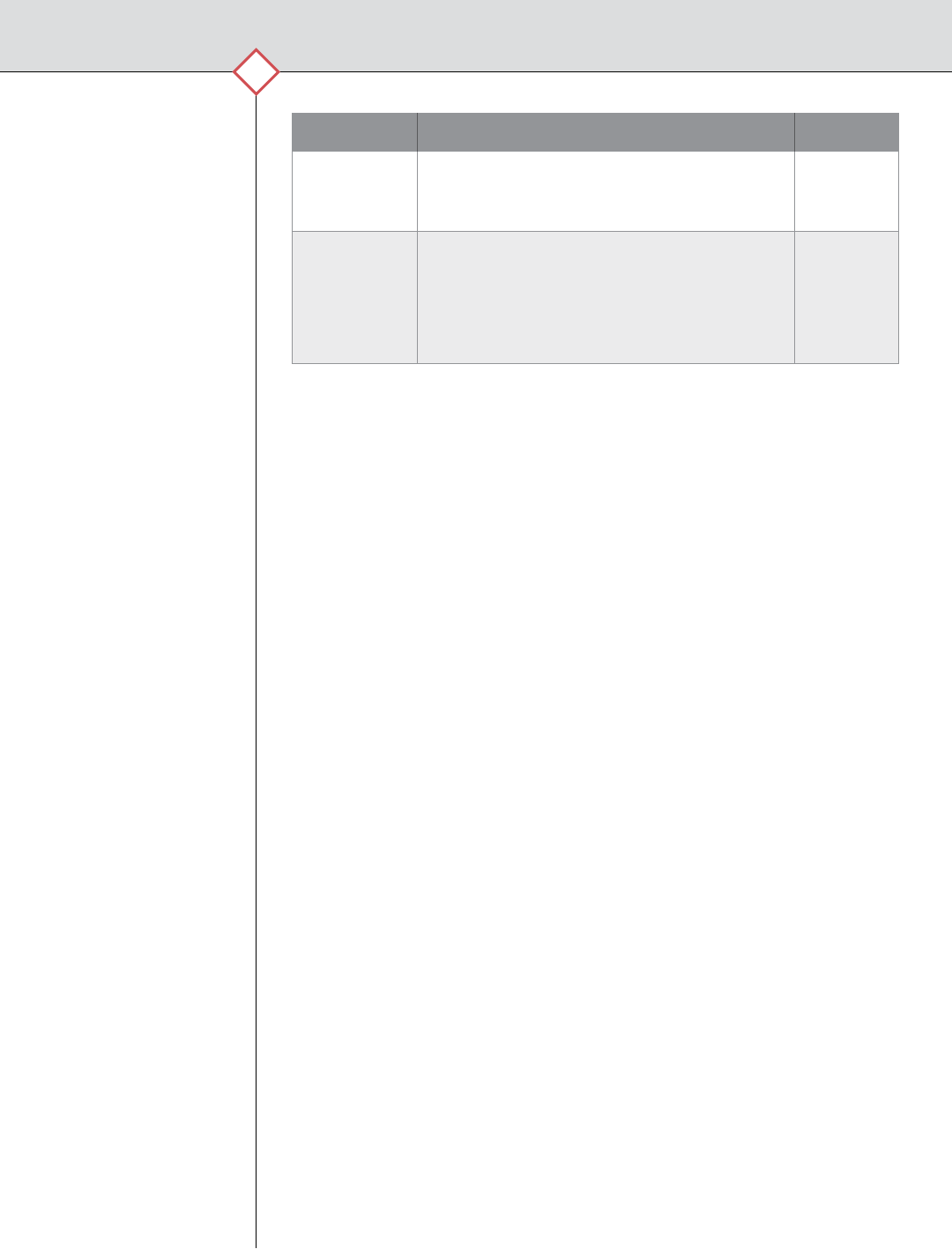
2
Who What By Date
Employers Update labels on “workplace” containers and train
employees on newly identified hazards. Update the
hazard communication program as needed.
June 1, 2016
All Until the dates listed in this table, you may comply
with either the:
-
New requirements in WAC 296-901-140, and/or
-
Current Hazard Communication rules
(WAC 296-800-170).
June 1, 2016
Which state agency administers this rule?
The Washington State Department of Labor & Industries (L&I)
administers this rule and other occupational safety and health rules
through its Division of Occupational Safety and Health (DOSH).
The Hazard Communication rule is part of the Washington
Administrative Code, WAC 296-901-140.
Do I need to read the Hazard Communication rule?
Yes! This booklet alone will not explain all of the requirements of the
Hazard Communication rule. You can easily access the rule on the L&I
website: www.Lni.wa.gov/Safety/Rules/Chapter/901 . Visit the Hazard
Communication topic page at www.Lni.wa.gov/Safety/Topics/AtoZ/GHS
for additional resources, such as:
A sample written program for chemical hazard communication
Sample forms
Training materials
Safety videos
If you have one or more employees who handle or are exposed to
chemicals at your workplace, you must comply with this rule to meet
your obligations as an employer. Failure to do so could lead to safety
and health citations and penalties.
How will this booklet help me?
This booklet describes the requirements of a hazard communication
program. It provides:
A checklist you can use to make certain you meet all of the
requirements of the Hazard Communication rule.
Questions and answers about employer requirements, including
information specic to agriculture.
Information on starting your employee training program.
This information goes beyond what is contained in the Hazard
Communication rule.
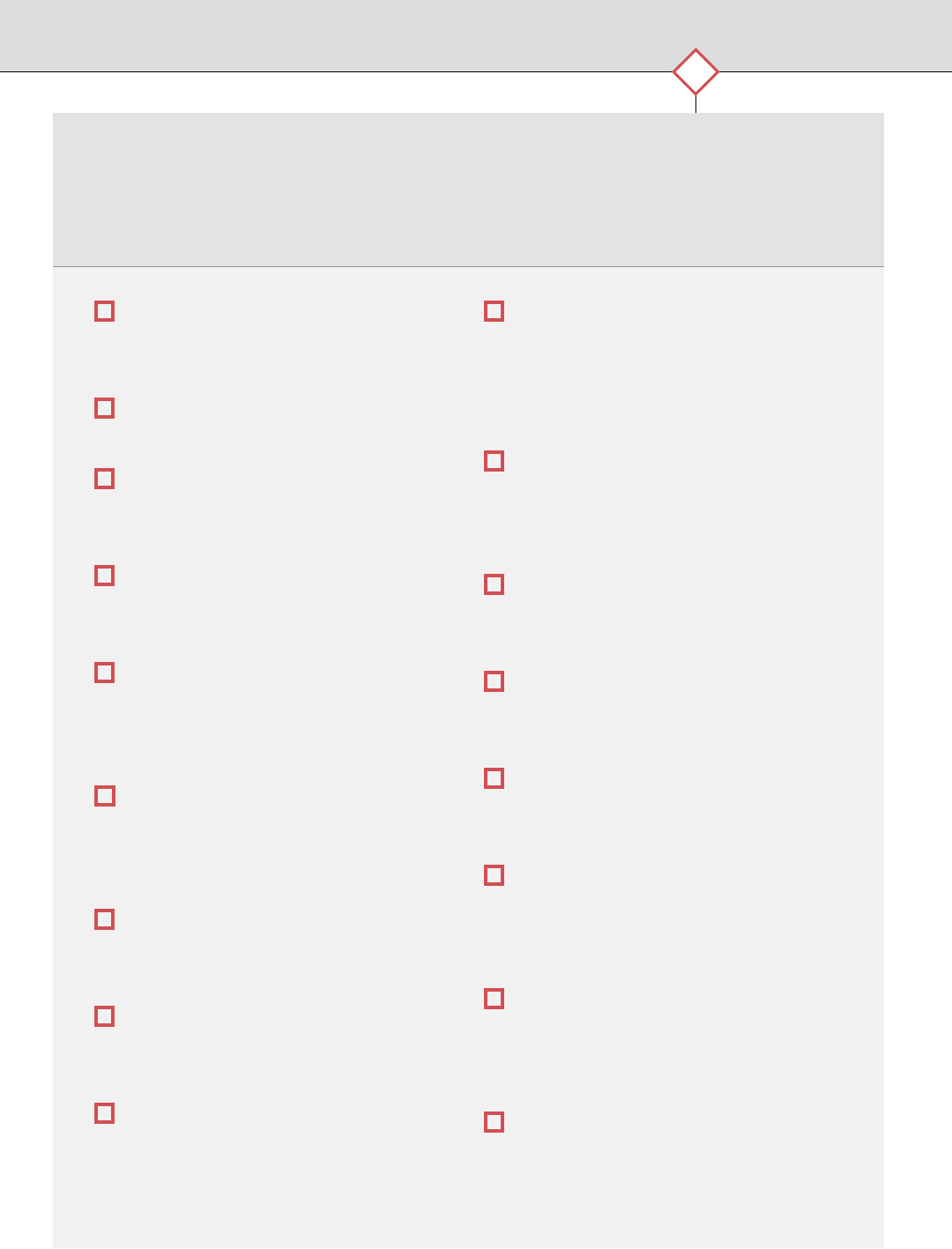
3
Checklist of Requirements
In addition to reading the Hazard Communication rule, ask yourself the
following questions to determine if your business has met all the safety
and health requirements for the rule:
■
Have we prepared a list of all
the hazardous chemicals in the
workplace?
■
Do we update our hazardous chemical
list regularly?
■
Have we obtained or developed a
Safety Data Sheet (SDS) for each
hazardous chemical we use?
■
Do we have a system to ensure that
we check all incoming hazardous
chemicals for proper labels and SDSs?
■
Do we have procedures to ensure
proper labeling or warning signs
for containers that hold hazardous
chemicals?
■
Are employees aware of the
specific information and training
requirements of our hazard
communication program?
■
Are employees familiar with the
different types of chemicals and the
hazards associated with them?
■
Have employees been informed of
the hazards associated with
performing non-routine tasks?
■
Do employees understand how
to detect the presence or release
of hazardous chemicals in the
workplace?
■
Are employees trained about
proper work practices and personal
protective equipment in relation to
the hazardous chemicals in their
work areas?
■
Does our training program provide
information on appropriate first aid,
emergency procedures and the likely
symptoms of overexposure?
■
Does our training program include an
explanation of labels and warnings
that are used in each work area?
■
Does our training describe where to
obtain SDSs and how employees may
use them?
■
Do we have a system to ensure that
we train new employees before
beginning work?
■
Have we developed a system to
identify new hazardous chemicals
before we introduce them into a
work area?
■
Do we have a system for informing
employees when we learn of new
hazards associated with a chemical
we use?
■
Do we have a records retention
system that will retain the SDSs or
the alternative record for a minimum
of 30 years?

4
Topic
Safety Data Sheets (SDSs)
Labels and Record Keeping
Training Your Employees
General Provisions of the Rule
How the Rule Applies to Different Chemicals or Products
Hazard Communication in Agriculture
The Role of the Department of Labor & Industries
Hazardous Chemicals in Communities
4
6
8
9
10
11
11
12
Safety Data Sheets (SDSs)
1. If I buy a hazardous chemical from a retail outlet (such as rust remover
from a hardware store or fertilizer from a nursery), who will provide
the SDS?
Retail distributors are required to provide SDSs to only those
customers with commercial accounts who make requests. The
retailer must post a sign informing employers that an SDS is
available. If you do not have a commercial account, you are
responsible for requesting an SDS from the manufacturer, importer
or wholesale distributor.
Wholesale distributors selling hazardous chemicals to employers
over the counter may also provide SDSs upon the request of the
employer at the time of the over-the-counter purchase, and they
must also post a sign or otherwise inform such employers that an
SDS is available.
If you do not have a commercial account and you purchase a
hazardous chemical from a retail distributor not required to
have an SDS on le (such as if the retail distributor does not have
commercial accounts and does not use the materials), the retail
distributor must provide you, upon request, with the name, address
and telephone number of the chemical manufacturer, importer or
distributor so that you can get an SDS.
Questions and Answers about the
Hazard Communication Rule

5
2. Are farm-chemical distributors required to provide SDSs?
Yes. All manufacturers, importers and distributors must provide
SDSs to employers who purchase hazardous chemicals. This
includes pesticide dealers. Pesticide applicators that sell pesticides
are considered distributors for the purposes of the rule.
3. What should I do if I get an SDS with blank spaces on it?
Contact the manufacturer or importer for a complete SDS. The
person who prepares the SDS must ll out the form completely
All elements of an SDS are now required; if no relevant
information is found for any subheading within a section on the
SDS, it must be marked to indicate that no applicable information
was found.
4. Who is responsible for the accuracy of SDSs?
The manufacturer, importer or employer preparing the SDS must
make certain the information accurately reects the scientic
evidence used in making the hazard determination.
5. Can SDSs be kept and made available electronically as long as employees
have proper access and knowledge of how to use them?
Yes. The rule says that an SDS may be in any form as long as it
contains the required information. You must make certain the
required information is provided for each hazardous chemical
and is readily accessible to employees in each work area on
each shift.
6. How often do SDSs need to be updated?
Each SDS must be updated within three months of the time the
manufacturer, importer or employer learns of any signicant new
information pertaining to the hazards of the chemical or ways to
protect against the hazards.
7. Do I have to obtain SDSs on hazardous chemicals we don’t use very often?
Yes. You must keep an SDS on each hazardous chemical used in
your workplace.
8. Do contractors have to make SDSs available to their employees when they
are working at non-fixed locations, such as construction sites?
Yes. SDSs may be kept at the contractor’s permanent base if
employees leave and return from that location on a daily basis.
Contractors who establish a temporary base, such as a trailer at a
work site, are required to have SDSs available at the site.

6
9. Must SDSs be translated into a foreign language if the majority of workers
don’t speak English?
No. However, a reasonable effort must be made to inform all
employees of the hazards in the workplace. L&I will, upon request,
provide assistance with translations for the following languages:
Cambodian, Chinese, Korean, Spanish and Vietnamese.
10. Will L&I approve all SDSs?
No. L&I does not approve the content of SDSs but will review them
on a spot-check basis for completeness and accuracy.
11. How are laboratories covered under the rule?
Laboratories, including school and college labs, have limited
coverage under the rule as described in WAC 296-901-14004. They
must follow the “Hazardous Chemicals in Labs” rule, WAC 296-828,
if it applies.
12. Are laboratories required to obtain SDSs for all hazardous chemicals, even
those that are old or infrequently used?
No. Laboratories are only required to keep SDSs that are received
for hazardous chemicals. These SDSs must be available to laboratory
personnel at all times. L&I recommends that laboratories obtain as
many SDSs as possible to help in developing their training programs.
13. Are schools and colleges required to tell students about the hazards of
chemicals they handle or are exposed to?
Teaching assistants, laboratory assistants and students employed
by schools are covered under the Hazard Communication rule and
must receive information and training.
14. If I don’t get an SDS with a product, can I assume it’s not hazardous?
No. You should call or write the manufacturer and ask for an SDS if
you suspect a chemical may be hazardous.
Labels and Record Keeping
15. What does the rule require for labeling?
The Hazard Communication rule requires that all workplace
containers of hazardous chemicals, including pesticides, be labeled,
tagged or marked with at least the following information:
a. Product identier
b. Signal word
c. Hazard statement(s)
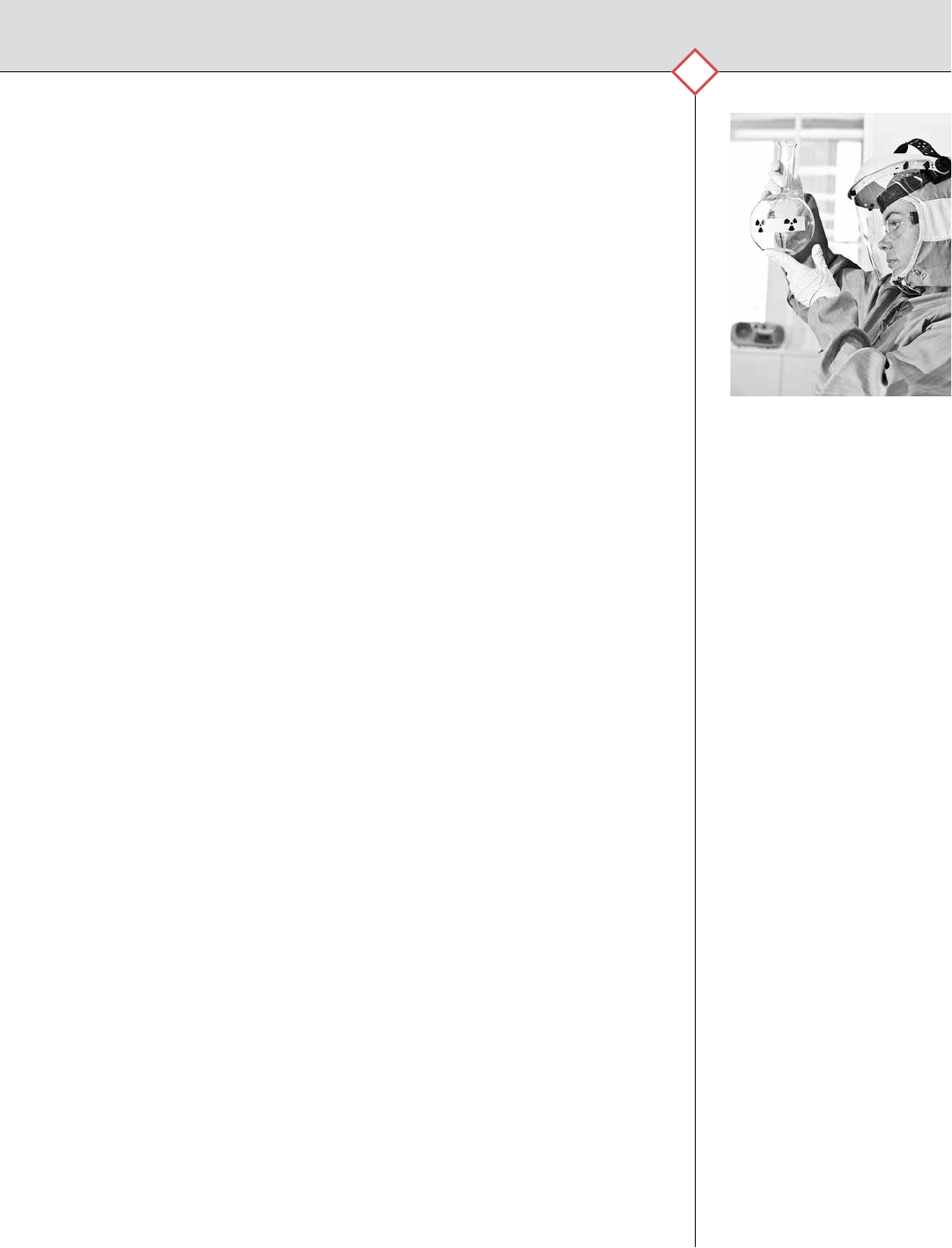
7
d. Pictogram(s)
e. Precautionary statement(s) (applies only to shipping activities)
f. Name, address, and telephone number of the manufacturer, importer
or other responsible party (applies only to shipping activities).
Pesticide container labels regulated by EPA satisfy this requirement.
However, the Hazard Communication rule says that pesticides cannot
be put into unmarked containers and left unattended. Powered-air
spray tanks, hand-carried tanks or backpack tanks do not need to be
labeled when – and only when – the employee using the container
personally transferred the chemical from a labeled container and the
solution will be used immediately by the same employee.
16. Do all containers need to be labeled?
No. Portable containers that meet the “immediate use” criteria of
the rule do not have to be labeled.
17. Must labels be translated into a foreign language if the majority of workers
don’t speak English?
No. However, a reasonable effort must be made to inform all
employees of the hazards in the workplace. L&I will, upon request,
provide assistance with translations for the following languages:
Cambodian, Chinese, Korean, Spanish and Vietnamese. Written
request for translations may be sent to:
Department of Labor & Industries
Right-To -K now Program
P.O. Box 44610
Olympia WA 98504-4610
18. Do pipes and piping systems containing chemicals need to be labeled?
No. The rule requires only containers to be labeled. Pipes and
piping systems are not considered containers for the purpose of
hazard communication. (Other regulations may require pipes
and piping systems to be identied.) However, you must have a
method of informing your employees of the hazards of non-routine
tasks (for example, the cleaning of reactor vessels) and the hazards
associated with chemicals contained in unlabeled pipes in their
work areas.
19. Does a list of SDSs satisfy the requirement of a hazardous chemical
inventory?
Yes, as long as the product names or chemical names used on the
inventory are the same as those used on the SDSs and labels. A
copy of the list must be made available to employees.

8
Training Your Employees
20. If there is more than one employer at a single job site, who is responsible
for employee training?
Each employer must train his or her own employees. However,
if an employer hires employees on contract from a temporary
employment service, the hiring employer is responsible for
informing and training the temporary worker(s) about hazardous
chemicals at the work site.
21. Will employees who rarely encounter hazardous chemicals need to be trained?
Yes. Employees must be trained on any hazardous chemical to
which they could be exposed. Training should address the type of
exposure possible and the degree of hazard involved.
22. Do I have to train employees about handling each brand of chemical?
No. Different brands of the same chemical have the same hazard.
Information and training about one brand is considered to apply to
the other brands.
23. Do workers have to be retrained whenever a new brand is introduced into
the work area?
No. However, workers must be retrained whenever a new chemical
hazard is introduced.
24. Does a packaged instructional program satisfy the requirements for
training under the Hazard Communication rule?
No. General instructional programs can help to train your
employees, but they will not completely satisfy the training
requirements. You also need to create a written training program
and provide training on the specic hazardous chemicals used in
your workplace.
25. Is generic training acceptable if we use large numbers of chemicals?
Yes. The rule does not specify how training is to be performed. It
only species who will be trained and the minimum content of
the training. Grouping chemicals with similar hazards for training
purposes is acceptable.
26. Do I have to keep records about who has received training on hazardous
chemicals?
No. The rule does not require documentation of employee
training, but L&I recommends that you keep records to verify your
compliance with the employee training requirements.

9
General Provisions of the Rule
27. Does a complete list of hazardous substances exist?
No. However, there are several sources that list hazardous substances
or criteria for determining whether chemicals are hazardous. These
include the general occupational health standards (Chapter 296-62
WAC); Pre-GHS, Employer Chemical Hazard Communication
(WAC 296-800-170); Permissible exposure limits (PELs)
—
Airborne
Contaminants (WAC 296-841-20025); OSHA Guidance for Hazard
Determination (www.OSHA.gov/dsg/hazcom/ghd053107.html ); and
the latest edition of the ACGIH Threshold Limit Values Handbook,
available online at www.acgih.org .
28. Can I conduct my own hazard evaluation of a chemical?
Yes. If you choose not to rely on the manufacturer’s or importer’s hazard
evaluation, you have the right to evaluate a chemical yourself. You must
follow the requirements for hazard determination as dened in the rule.
You will be responsible for the completeness and accuracy of the
data sheet.
29. If my company is small, or I use only one or two hazardous chemicals, must
I still comply with the rule?
Yes, if you have employees, you must comply with the Hazard
Communication rule no matter how small your company or how
few hazardous chemicals you use.
30. Who is considered to be a chemical importer?
An importer is considered to be the rst business within the
customs territory of the United States that receives hazardous
chemicals produced in other states or countries. Importers who are
employers must also comply with the applicable sections of the rule.
31. Does the rule apply to refuse collectors and landfill operators?
Hazardous chemicals purchased for use by refuse collectors are
covered under this rule, but materials received for disposal are not.
Workers are protected from the hazards of disposal through the
accident prevention program required under WAC-296-800-140.
32. Are contractors required to notify employers about hazardous chemicals
on a job site?
Yes. Just as employers have the obligation to notify contractors
about hazardous chemicals at the work site, contractors are required
to provide SDSs at a central location for each hazardous chemical
to which the employees may be exposed. They are also required to
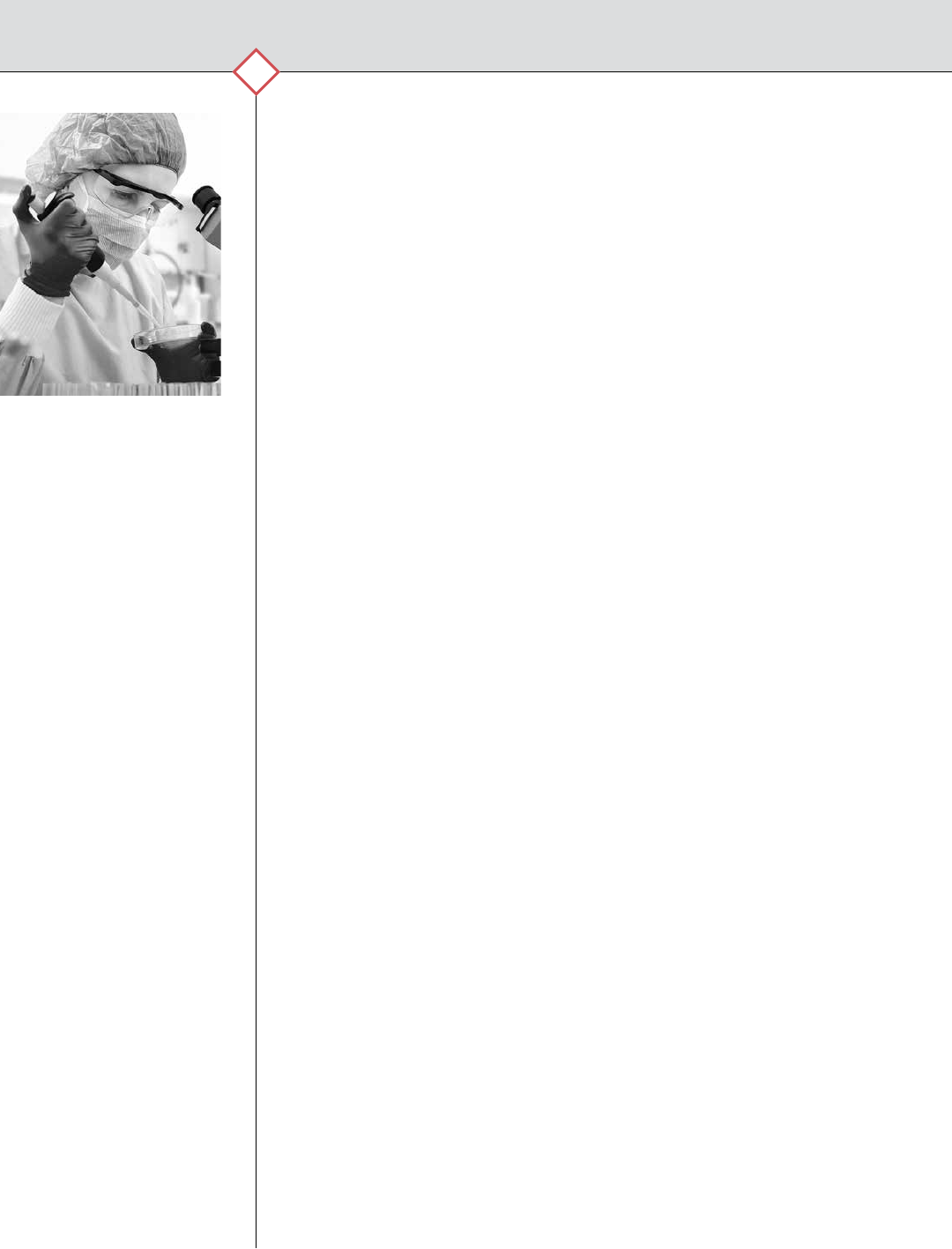
10
inform the employer of any precautionary measures necessary as a
result of hazardous chemicals they use, and provide an explanation
of the labeling system used for their hazardous chemicals.
How the Rule Applies to Different Chemicals
or Products
33. Are off-the-shelf products covered under this rule?
Yes. Consumer products are considered to be hazardous if there are
hazard warnings on the label that indicate a potential for physical
or health hazards.
34. Are radioactive chemicals covered under this rule?
Yes. Since the purpose of the Hazard Communication rule is
to protect employees from hazardous chemicals, radioactive
chemicals are covered. Other radioactive materials, such as those
used in medical treatment, are regulated by the Washington State
Department of Health under WAC 246-220 through 254.
35. How are pharmaceuticals covered by the rule?
The rule covers pharmaceutical drugs such as antineoplastic
(chemotherapy) agents, drugs that may cause eye or skin irritation,
and drugs that have carcinogenic potential or known toxic effects
when employees handle them.
Note: L&I adopted a Hazardous Drugs rule on Jan. 3, 2012,
with implementation beginning Jan. 1, 2015. See the Hazardous
Drugs topic page at www.Lni.wa.gov/Safety/Topics/AtoZ/
HazardousDrugs for more information.
36. Are wood products exempt from labeling and SDS requirements?
Wood and wood products are exempt, but wood dust and chemical
preservatives are covered and must be treated accordingly. In
addition, if sawing, sanding or other processing releases wood dust
into the air, the wood product is covered.
37. Are bricks and cinder blocks exempt from this rule?
Bricks and cinder blocks are exempt from the rule unless they are
cut or drilled. Cutting or drilling bricks or cinder blocks releases
silica dust into the air and silica is a serious health hazard. For more
information about silica, see WAC 296-841 Airborne Contaminants
at www.Lni.wa.gov/Safety/Rules/Chapter/841 . Permissible
Exposure Limits (PELs) for Airborne Contaminants can be found in
WAC 296-841-20025 Table 3.

11
38. Are biological agents covered under this rule?
No. Biological agents such as microorganisms are not included in
the denition of a chemical.
Hazard Communication in Agriculture
39. Does the Hazard Communication rule cover all agricultural employees
including seasonal and temporary employees?
Yes. All agricultural employees who handle or are potentially exposed
to hazardous chemicals must be included in the employer’s hazard
communication program. This includes pesticides and pesticide use.
40. Are agricultural employers exempt from the requirements to develop a
written hazard communication program?
No. All agricultural employers must develop a written hazard
communication program if their employees can be exposed, under
normal conditions of use or in a foreseeable emergency, to any
hazardous chemical including a pesticide.
41. As an agricultural employer, do I have to obtain SDSs for pesticides in
addition to the pesticide label?
Yes. SDSs must be obtained for all hazardous chemicals, including
pesticides that employees may encounter in their work activities.
42. Can agricultural employers who use pesticides combine elements of their
employee training and written hazard communication program with similar
training or written materials that may be required under other federal or
state pesticide regulations?
Yes. The intent of the rule is not to require duplicative programs if
requirements overlap with elements of other regulations. However,
the hazard communication program must include all chemicals and
not be limited to pesticides.
The Role of the Department of Labor & Industries
43. What will L&I do about manufacturers or importers located outside
Washington who do not provide SDSs?
L&I will take administrative and legal action, if necessary, to get
SDSs from uncooperative manufacturers, importers or distributors.
Federal OSHA will also assist in obtaining SDSs.
44. Will L&I evaluate the validity of trade secret claims?
Yes, however, L&I will use discretion in selecting specic claims
for evaluation.

12
Hazardous Chemicals in Communities
45. Whom do I contact about hazardous chemicals in my community?
The Washington State Department of Ecology administers the
Community Right to Know Act and other hazardous-waste
disposal laws. For information about hazardous chemicals in your
community, visit www.ecy.wa.gov/epcra .
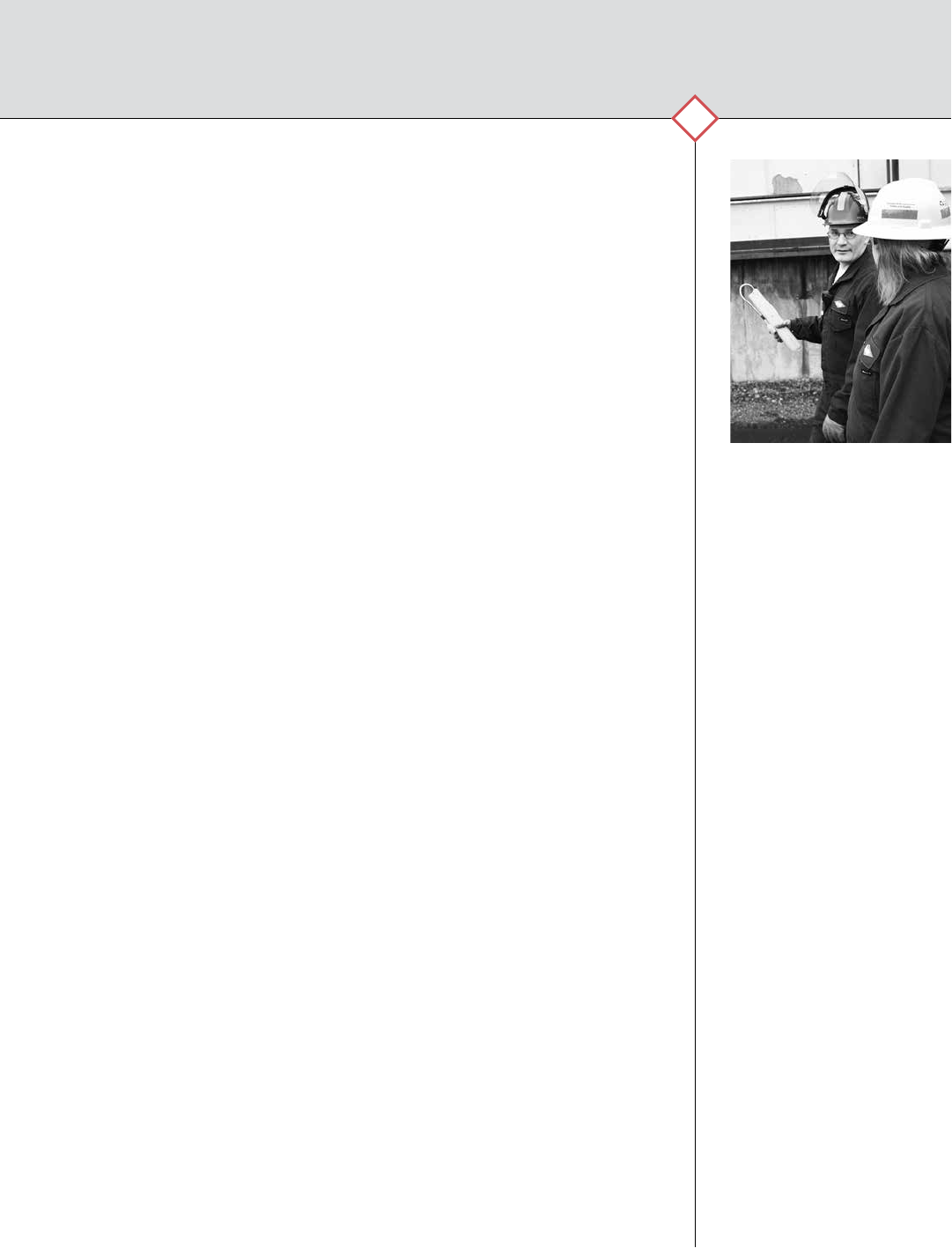
13
Starting Your
Employee Training Program
The Hazard Communication rule requires you to develop and maintain
a written training program for both new and experienced employees and
to give all your employees information about the program.
Employees who are directly or potentially exposed to hazardous
chemicals on the job must receive additional information on the
particular hazards of the chemicals to which they are exposed or
potentially exposed. They also must be trained. You also must provide
training when a new chemical hazard is brought into the workplace.
Hazard communication training information and materials are available
at www.Lni.wa.gov/Safety/Topics/AtoZ/GHS . You will need to add
information specic to your workplace to meet the training requirements.
Step 1: Know the requirements
Read the employee training requirements of the Hazard
Communication rule
—
WAC 296-901-14016.
Step 2: Identify employees who must be trained
Determine which employees are exposed or potentially exposed to
hazardous chemicals in your workplace. These employees require
training beyond the information provided to all employees. (See the
sidebar on Page 15, How to Determine Your Employees’ Exposure
to Chemicals.)
Step 3: Inform all employees
Develop a program to inform all employees about:
The requirements of the Hazard Communication rule.
Any operations in their work areas that involve hazardous chemicals.
The location and availability of the written hazard communication
program, including the list(s) of hazardous chemicals and SDSs.
Step 4: Train employees who may have actual or potential exposure
The information and training your employees receive must be tailored
to the types of hazards and exposures they encounter. This training
must cover:
Details of the hazard communication program. The program and
training should explain the labeling system and SDSs, and include
instructions on how to obtain and use hazard information.
The location of your written hazard communication program, lists
of hazardous chemicals and data sheets.

14
How these employees can detect the presence or release of
hazardous chemicals.
Physical and health hazards of hazardous chemicals in the work
area, information about rst aid, emergency procedures and the
likely symptoms of overexposure.
How employees can protect themselves through exposure
control methods, including work practices, engineering controls,
administrative controls, personal protective equipment and
emergency procedures.
When and how to report leaks and spills.
Where to get more information.
Consider a system for documenting employee training. For example,
employees could sign a form to verify that they attended the training
and understand the company’s hazard communication policy. This is
not a requirement but is a recommended option for your program.
Follow up after training sessions. Be sure that employees know how
to handle chemicals and are using the training they were given. When
your employees use protective equipment, be sure to keep it clean and
properly maintained. Make certain it is available to your employees
and they are using it.

15
Follow each chemical from storage through use to disposal.
Determine which employees are or could be exposed to it.
Review your existing methods for controlling exposure to
hazardous substances. The best method is to eliminate the
hazard at the source. If elimination is not possible, control
the hazard at its source with engineering controls, or limit
worker exposure using administrative controls. If these
two methods are not enough to remove or reduce the
worker exposure to acceptable levels, then use personal
protective equipment. List specific procedures for each
work area and substance.
1. Engineering controls, including exhaust ventilation
systems, dust collection systems and process
enclosures.
2. Administrative controls, such as having a standby
person for confined-space entry, rotating employees
to reduce exposure, lockout/tagout procedures and
substituting a non-toxic or less toxic chemical.
3. Personal protective equipment you provide such
as respirators, gloves, boots, aprons, goggles and
face shields.
Review your current chemical handling procedures and
compare them to recommended practices indicated on the
label or SDSs. This will help identify where you may need to
improve your procedures.
List the emergency procedures for each work area and
each substance.
Good emergency response procedures help protect the
safety and health of your employees and reduce the
potential loss of property and equipment.
How to Determine Your Employees’ Exposure to Chemicals
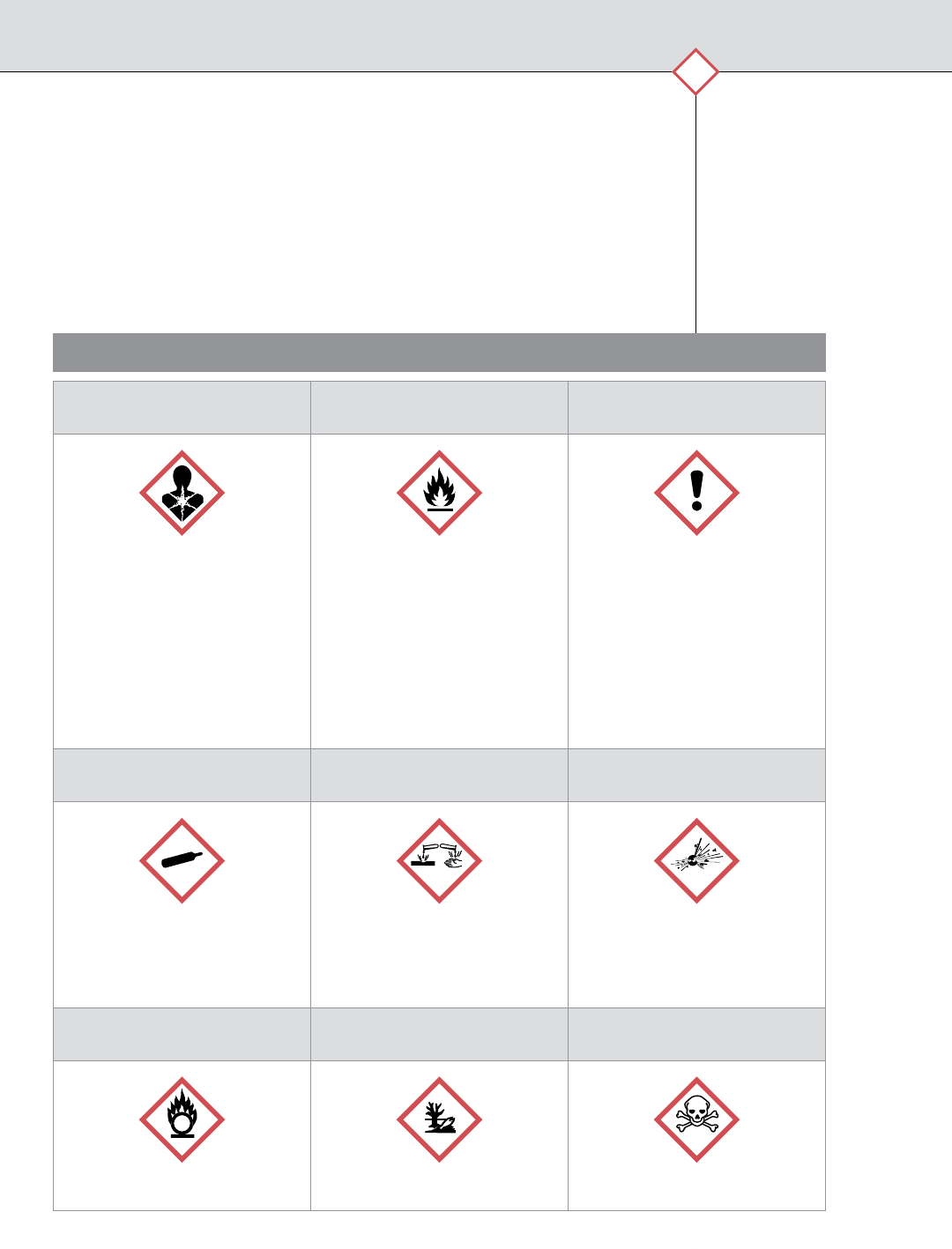
17
Pictograms
As of June 1, 2015, the Hazard Communication rule will require
pictograms on labels to alert users of the chemical hazards to which
they may be exposed. Each pictogram consists of a symbol on a white
background framed within a red border and represents a distinct
hazard(s). The pictogram on the label is determined by the chemical
hazard classication.
Appendix
HCS Pictograms and Hazards
Health Hazard Flame Exclamation Mark
Carcinogen
Mutagenicity
Reproductive toxicity
Respiratory sensitizer
Target organ toxicity
Aspiration toxicity
Flammables
Pyrophorics
Self-heating
Emits flammable gas
Self-reactives
Organic peroxides
Irritant (skin and eye)
Skin sensitizer
Acute toxicity (harmful)
Narcotic effects
Respiratory tract irritant
Hazardous to ozone layer
(non-mandatory)
Gas Cylinder Corrosion Exploding Bomb
Gases under pressure
Skin corrosion/burns
Eye damage
Corrosive to metals
Explosives
Self-reactives
Organic peroxides
Flame Over Circle
Environment
(Non-mandatory)
Skull and Crossbones
Oxidizers
Aquatic toxicity
Acute toxicity (fatal or toxic)
(From OSHA QuickCard 3491)
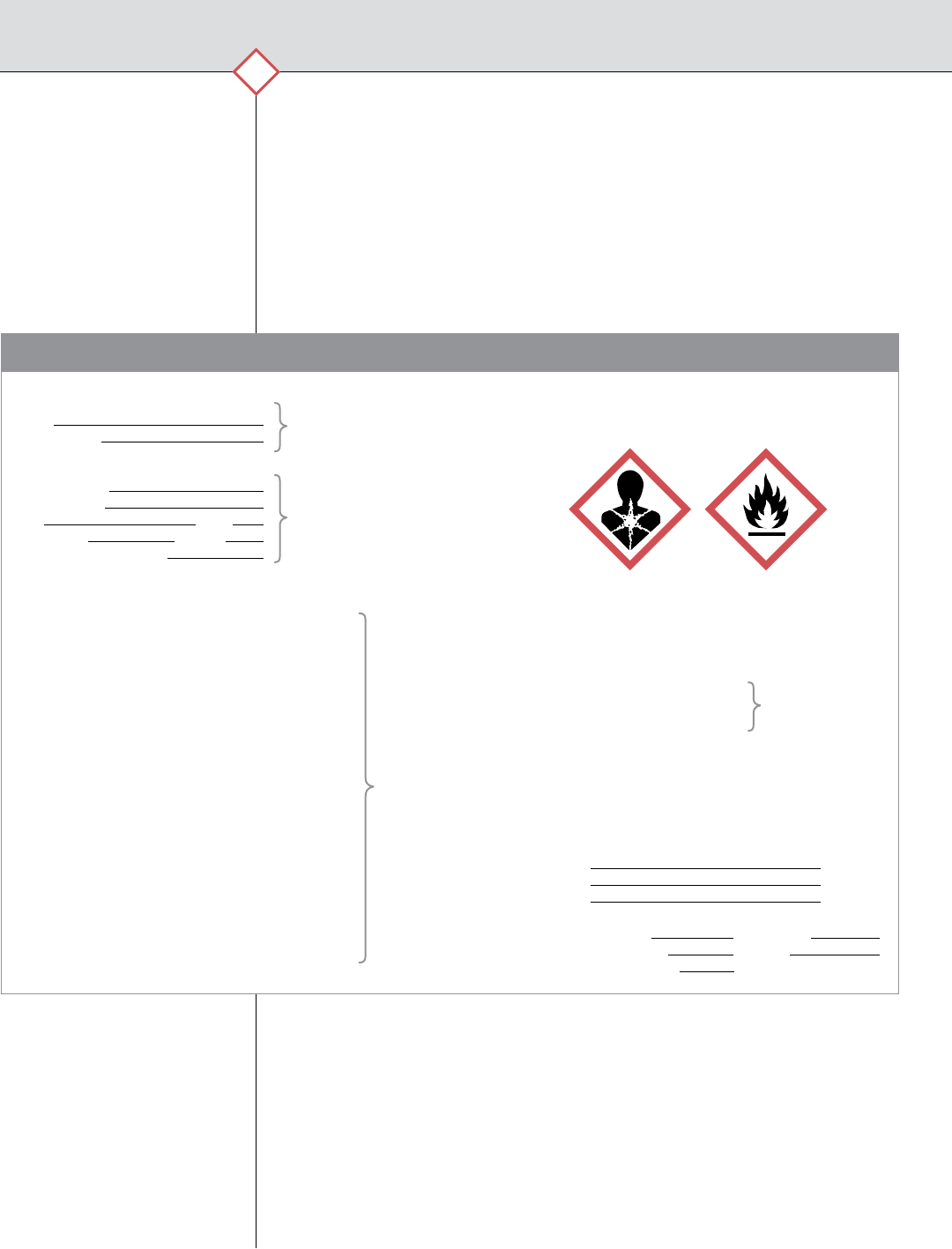
18
Labels
As of June 1, 2015, all labels will berequired to have
pictograms, a signal word, hazard andprecautionary statements,
the product identier, andsupplier identication. A sample
revised label,identifying the required label elements, is shown
below. Supplemental information can also be providedon the
label as needed.
Supplemental Information
CODE
Product Name
Product
Identifier
Company Name
Street Address
City State
Postal Code Country
Emergency Phone Number
Supplier
Identification
Fill weight: Lot Number:
Gross weight: Fill Date:
Expiration Date:
Directions for Use
Keep container tightly closed. Store in a cool,
well-ventilated place that is locked.
Keep away from heat/sparks/open flame. No smoking.
Only use non-sparking tools.
Use explosion-proof electrical equipment.
Take precautionary measures against static discharge.
Ground and bond container and receiving equipment.
Do not breathe vapors.
Wear protective gloves.
Do not eat, drink or smoke when using this product.
Wash hands thoroughly after handling.
Dispose of in accordance with local, regional, national,
international regulations as specified.
In Case of Fire: Use dry chemical (BC) or Carbon Dioxide (CO
²
)
fire extinguisher to extinguish.
First Aid
If exposed call Poison Center.
If on skin (or hair): Take off immediately any contaminated
clothing. Rinse skin with water.
Precautionary
Statements
Hazard
Statements
Highly flammable liquid and vapor.
May cause liver and kidney damage.
Hazard Pictograms
Signal Word
Danger
Sample Label
(From OSHA QuickCard 3492)
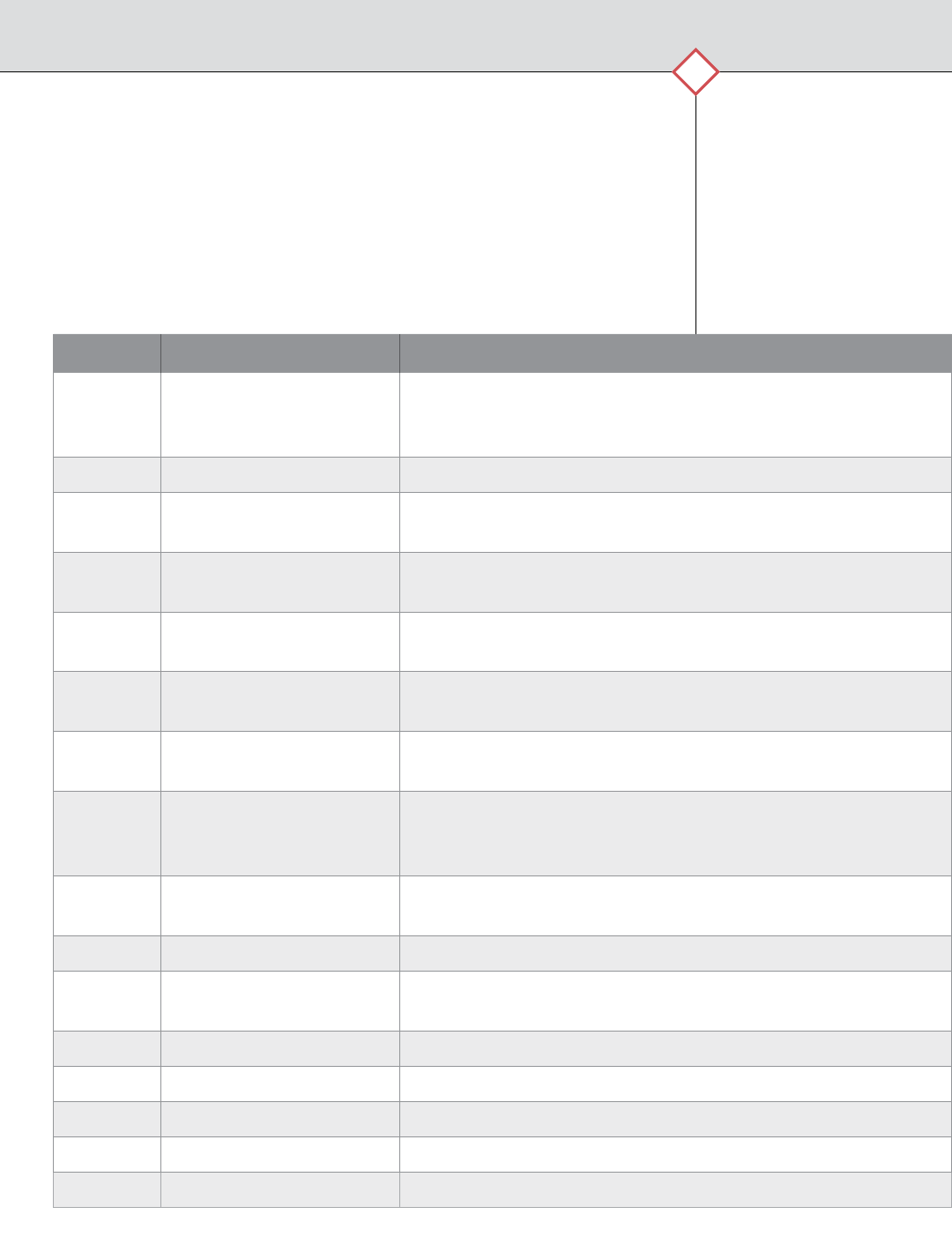
19
Safety Data Sheets
A safety data sheet (SDS) must include the information specied in the
table under the section number and heading indicated for sections 1–11
and 16. If no relevant information is found for any given subheading
within a section, the SDS must clearly indicate that no applicable
information is available. Sections 12–15 may be included in the SDS,
but are not mandatory.
(Adapted from OSHA QuickCard 3493)
Section Heading Relevant Information
Section 1 Identification Includes product identifier;manufacturer or distributor name,
address, phone number; emergency phone number; recommended
use; restrictions on use.
Section 2 Hazard(s) identification
Includes all hazards regarding the chemical; required label elements.
Section 3 Composition/information on
ingredients
Includes information on chemical ingredients; trade secret claims.
Section 4 First-aid measures Includes important symptoms/effects, acute, delayed; required
treatment.
Section 5 Fire-fighting measures Lists suitable extinguishing techniques, equipment; chemical
hazards from fire.
Section 6 Accidental release
measures
Lists emergency procedures; protective equipment; proper methods
of containment and cleanup.
Section 7 Handling and storage Lists precautions for safe handling and storage, including
incompatibilities.
Section 8 Exposure controls/
personal protection
Lists Permissible Exposure Limits (PELs); Threshold Limit Values
(TLVs); appropriate engineering controls; personal protective
equipment (PPE).
Section 9 Physical and chemical
properties
Lists the chemical’s characteristics.
Section 10 Stability and reactivity Lists chemical stability and possibility of hazardous reactions.
Section 11 Toxicological information Includes routes of exposure; related symptoms, acute and chronic
effects; numerical measures of toxicity.
Section 12 Ecological information Non-mandatory
Section 13 Disposal considerations Non-mandatory
Section 14 Transport information Non-mandatory
Section 15 Regulatory information Non-mandatory
Section 16 Other information Includes the date of preparation or last revision.
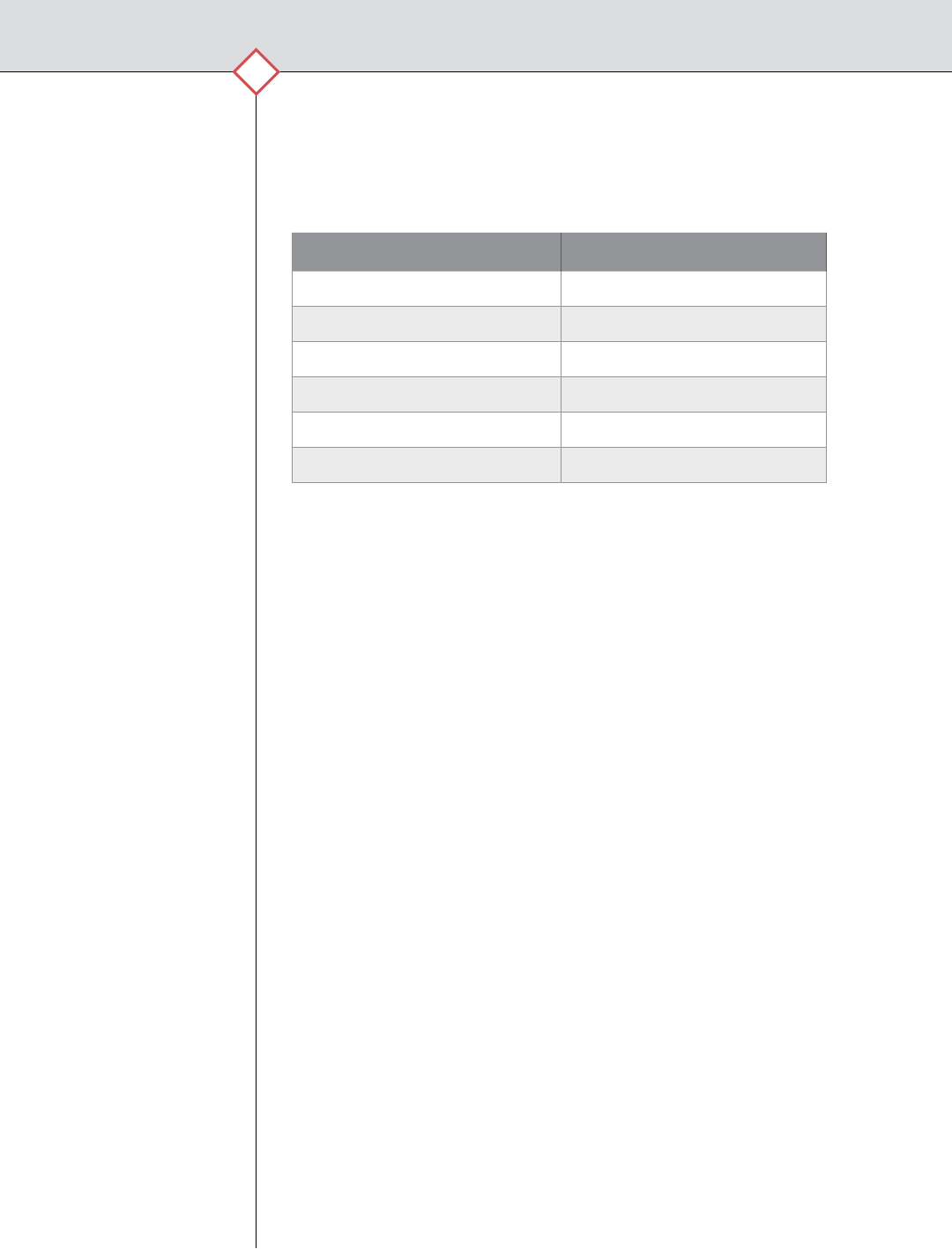
20
The Department of Labor & Industries will help you meet the
requirements of the Hazard Communication rule. For assistance,
contact the nearest L&I ofce and ask to speak to an Industrial
Hygiene Consultant, or visit www.Lni.wa.gov/Safety/Consultation .
Business Location Call
Northwest Washington 425-290-1431
King County 206-515-2837 or 206-835-1146
Pierce County/Olympic Peninsula
253-596-3917
Southwest Washington 360-902-5472
Central Washington 509-886-6570
Eastern Washington 509-324-2543
For more information on Hazard Communication, visit
www.Lni.wa.gov/Safety/Topics/AtoZ/GHS .
Where to Get Help

PUBLICATION F413-012-999 [07-2014]
Upon request, foreign language support and formats for persons
with disabilities are available. Call 1-800-547-8367. TDD users,
call 360-902-5797. L&I is an equal opportunity employer.
